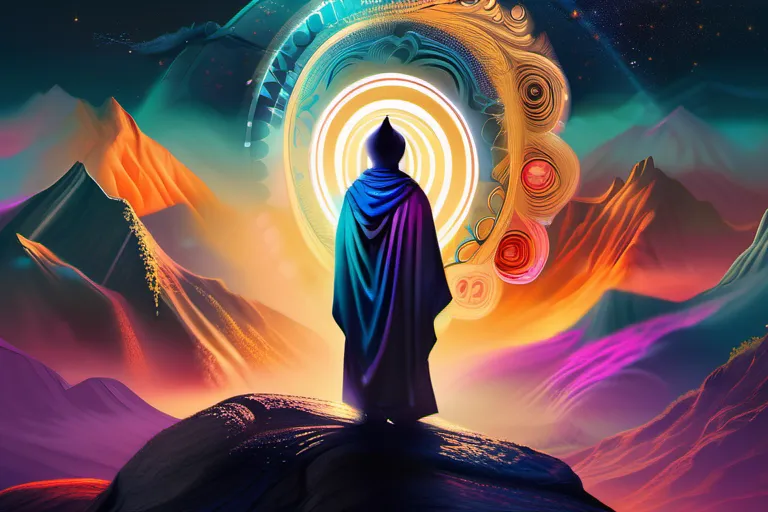Explore the profound spiritual teachings of Gnosticism, its impact on life, and how it differs from mainstream Christianity.
Gnosticism is an ancient religious and philosophical movement that emerged in the first century CE. Although it was suppressed by mainstream Christianity, its teachings continue to intrigue scholars and spiritual seekers alike. In this article, we delve into the spiritual and life teachings of Gnosticism, shedding light on its unique perspective.
The Origins and History of Gnosticism
Imagine a journey through time, where we trace the origins and history of Gnosticism, a spiritual movement that has captivated minds for centuries. What if this ancient path holds keys to understanding life and spirituality differently?
Gnosticism began in the early Christian era, around the 2nd century CE. It emerged as a response to the rigid practices of what would become mainstream Christianity. How did Gnostics view their origins and development within this broader context?
The roots of Gnosticism can be traced back to various sources, including Jewish mysticism, Greek philosophy, and early Christian teachings. One key figure in its development was Valentinus, a prolific teacher who introduced complex cosmological ideas. His followers spread his teachings across the Roman Empire, making significant contributions to the spiritual landscape.
Another important figure was Mary Magdalene, often celebrated for her role as a guide and leader within Gnostic communities. Her influence in early Christian history is a testament to the diverse roles women played. How did these figures shape the path of Gnosticism?
Gnosticism spread not only through teachings but also through texts like the Gospel of Thomas, which offers insights into its spiritual practices and beliefs. These texts highlight the movement’s focus on personal enlightenment and the knowledge that sets one free from material constraints.
The history of Gnosticism is a tapestry woven with threads of rebellion against dogma and quest for inner truth. From its inception to its eventual persecution, this spiritual journey offers profound lessons about the human soul’s yearning for liberation and understanding. How does the history of Gnosticism mirror the struggles we face today in seeking spiritual authenticity?
As we delve deeper into the beliefs of Gnosticism in our next chapter, consider how these ancient teachings might resonate with modern seekers of spirituality. The journey through the origins and history of Gnosticism is not just a recounting of past events but an exploration of timeless questions about reality and existence.
Gnostic Beliefs: The Nature of Reality
Imagine stepping into a world where the nature of reality is not what it seems. Gnosticism, with its rich and complex beliefs, offers a unique perspective on spirituality and life. In this realm, the divine is not confined to the material world but exists beyond our tangible understanding. This raises the question: How can we reconcile the spiritual with the physical?
Gnostics believe that the cosmos was created by a lesser deity, often referred to as the Demiurge, who mistakenly believed himself to be the one true God. This idea introduces an intriguing concept: the divine spark within each human soul is actually part of the higher, more perfect realm, a fragment of true divinity trapped in material existence.
This belief system challenges traditional views on the origin and nature of reality. How do we navigate such a dualistic universe where the spiritual and physical realms coexist but seem fundamentally at odds? Gnostics propose that through gnosis, or profound spiritual knowledge, one can liberate this divine spark and attain true enlightenment.
The material world is often seen as a prison for these souls, a place of illusion and suffering. This metaphor paints the physical realm as a veiled version of reality, with only those who seek gnosis able to see through the layers of deception. By recognizing this, we can begin to understand why Gnosticism places such emphasis on direct experience and inner knowledge rather than external doctrines.
In essence, Gnosticism invites us to question everything we think we know about the world around us. It challenges us to look beyond surface-level perceptions and delve into the deeper truths that lie within ourselves and the cosmos. As we explore this path, we must ask: How can we uncover our true nature and break free from the bonds of material illusion?
The Gnostic Path to Enlightenment
The Gnostic Path to Enlightenment: A Steep but Rewarding Climb
Imagine climbing a mountain, not just for the view at the peak, but because the journey itself is part of the adventure. For the Gnostics, their spiritual path towards enlightenment is much like this climb. They seek gnosis, which means knowledge or insight into the divine truths that set them free from the material world’s illusions.
In this metaphorical ascent, the soul plays a pivotal role. Think of it as your inner compass, guiding you through the layers of ignorance and toward greater understanding. The Gnostics believe in the divine spark within each person—a piece of the divine that seeks to be reunited with its source.
So, what are the steps involved in this spiritual journey? First, there’s self-awareness—understanding that your true essence is not bound by material form. Then comes practice. Gnostics engage in various practices such as meditation, prayer, and study of sacred texts to deepen their connection with the divine.
Another crucial element is gnostic communities. Just like climbers support each other on a mountain trail, Gnostics find strength in community. These gatherings offer mutual encouragement and shared learning experiences, reinforcing one’s journey towards enlightenment.
The path to enlightenment isn’t easy; it requires patience, persistence, and continuous self-reflection. But for those who embark on this journey, the rewards are immeasurable. The ultimate goal is not just spiritual knowledge but a transformative experience that reshapes one’s entire outlook on life.
Gnosticism vs. Mainstream Christianity
When delving into the teachings of Gnosticism versus mainstream Christianity, it’s like stepping into two vastly different landscapes—one mystical and enigmatic, the other structured and familiar. How do these paths diverge in their views on spirituality and life? Let’s explore this by first understanding what Gnostic Teachings truly entail.
In Gnosticism, the focus is on attaining a deep, personal knowledge (gnosis) of the divine. This knowledge isn’t just intellectual but involves experiencing the nature of the divine directly. Is it not like trying to understand the essence of a song by merely reading its lyrics? One must listen and feel the melody. Similarly, Gnostics believe that true spiritual growth comes from direct experience rather than adherence to dogma.
In contrast, mainstream Christianity often emphasizes faith in an external entity—a personal relationship with Jesus Christ—and adhering to a set of religious practices and doctrines. This is akin to following a map while exploring a forest; you rely on the directions to find your way, but there’s less emphasis on personal discovery and experience.
The core difference lies in their approach to salvation. Gnosticism posits that salvation comes from freeing oneself from ignorance (gnōsis), whereas Christianity focuses on redemption through faith in Christ. How can one truly be free if they are bound by the chains of uncertainty and fear? Gnostics argue that true freedom is found in understanding one’s own nature, not just following external rules.
Moreover, the view on the role of the soul differs significantly between the two. In Gnosticism, the soul (psyche) is seen as a vehicle for spiritual progress and an avenue to transcendence, much like a ship navigating uncharted waters towards a distant shore. On the other hand, mainstream Christianity often views the soul as a part of a larger divine plan, predestined in some sense.
So, when comparing these two paths, it’s clear that Gnosticism offers a more introspective and experiential journey to enlightenment. It challenges us to look within ourselves for answers rather than solely relying on external authorities or traditions. In this quest for self-knowledge, we find the true essence of our spiritual lives.
The Impact of Gnosticism on Modern Spirituality
The impact of Gnosticism on modern spirituality cannot be overstated, as it has seeped into many contemporary mystical traditions and movements. Have you ever wondered how the teachings of ancient Gnostic texts have influenced our modern understanding of spirituality?
One of the key areas where Gnosticism has left an indelible mark is in the New Age movement. Think about it: when you hear phrases like ‘knowing thyself’ or ‘reaching your divine potential,’ can you trace these ideas back to Gnostic teachings? The emphasis on self-discovery and enlightenment found in both Gnosticism and the New Age movement echoes a common thread, suggesting a profound impact of ancient wisdom on our contemporary spiritual practices.
Gnostic ideas have also influenced various mystical traditions that emerged over time. For instance, the concept of the Inner Light or the Spark within each individual—often seen as a reflection of the divine—is reminiscent of Gnostic beliefs about the inner divinity of humans. How many of us, in our spiritual quests, have sought to uncover and nurture this inherent divinity? This quest for self-realization is deeply rooted in Gnostic philosophy.
Moreover, the influence of Gnosticism extends to modern practices such as meditation and mindfulness. The idea that one can achieve a higher state of consciousness through contemplative practices aligns with Gnostic teachings about the path to spiritual awakening. Have you ever pondered how many contemporary spiritual practitioners are actually walking a path laid out by ancient Gnostics?
So, when we explore the modern spirituality landscape, it’s impossible not to see the echoes of Gnosticism. From self-help books that advocate for inner knowledge and enlightenment to practices like meditation and mindfulness, these are all part of a broader spiritual movement influenced by Gnostic thought.
Living a Gnostic Life: Practical Applications
Imagine waking up each morning to the realization that your true essence goes beyond the body and mind—what if you are a spark of divinity, a fragment of the divine essence yearning for reunion? This is the core belief in Gnostic teachings, a path that challenges conventional religious structures and encourages a direct experience of the divine.
So, how can one practically apply these profound spiritual teachings to their daily life? Start by recognizing your inner light. Just as the sun rises every morning, remind yourself that your true self is always shining, even if hidden beneath layers of ignorance or societal norms. Engage in practices like meditation and contemplation to peel away those layers and uncover your divine spark.
Integrate rituals that honor the sacred nature of life. Whether it’s lighting a candle in silence, celebrating seasonal festivals, or performing acts of service, these activities can become powerful symbols of your connection with the divine. They serve as reminders that everything you do is part of a greater cosmic dance.
Moreover, embrace a lifestyle that promotes healing and growth. Gnosticism teaches us that ignorance often lies at the root of suffering. Therefore, seek knowledge and truth in all aspects of life—read sacred texts, engage in meaningful dialogue with others, and explore your personal beliefs deeply. Each step towards understanding brings you closer to enlightenment.
Finally, cultivate a community that supports your spiritual journey. Just as a garden needs care and nurturing, so too does the soul thrive on companionship and shared wisdom. Find like-minded individuals who can offer support and encouragement along this path of discovery.
Conclusion
 Gnosticism offers a profound understanding of the human condition, the nature of reality, and the path to enlightenment. By embracing its teachings, we can gain valuable insights into our own spiritual journey and live more fulfilling lives.
Gnosticism offers a profound understanding of the human condition, the nature of reality, and the path to enlightenment. By embracing its teachings, we can gain valuable insights into our own spiritual journey and live more fulfilling lives.











